Elizabeth Banks‘ grisly horror-comedy Cocaine Bear has probably exceeded most expectations of how a movie with such a title could fare at the box office, where the film has taken in more than $80 million worldwide.
The star-studded film has been well-received by critics and audiences alike, and even its detractors seem to have fallen for the title character, who is lovingly referred to as “Cokie” by those who worked on the movie.
One of those who was particularly pivotal in the creation of Cokie was the film’s VFX Supervisor, Robin Hollander of Wētā FX, who used a variety of methods to make the impossible more possible without anyone being mauled or eaten. Yes, kids, we hate to break it to you, but Cokie was not a real bear. Instead, she was fully created by Wētā and its visual effects experts, who have won numerous Oscars. Hollander himself won a VES Award for his compositing work on 2017’s War for the Planet of the Apes.
Below the Line recently spoke with Hollander over Zoom for the following extensive look into the making of Cocaine Bear. You could say that Hollander has the gift of gab, but he was also enthusiastic about the work done by Wētā’s team to create Cokie.

Below the Line: You’ve been at Weta for some time now. Were you there before or during Lord of the Rings?
Robin Hollander: No, I think I first contacted Weta during King Kong, which I believe was in 2005. I was actually working on Harry Potter 4 at the time in London. I was based in London at the time, and that was our bread and butter industry. I approached Weta then because I think I liked the idea of coming out here. When I first reached out, they weren’t really hiring people just yet, but then I got on their radar, and then when they reached out again, [the] timing didn’t work out for me.
I think it was after that, [I’d] planted the seed that I wanted to go see the wide open world in 2006, [so I] did a bit of travel around the world and ended up at Weta, initially just on a half-year contract, [and then I] kept traveling around the world. As soon as I got back home to Switzerland, I reached out and said, ‘Hey, I want to come back as soon as I can.’ They had a little movie at the time called Avatar, which [had] just about kicked off, and I was like, “Yeah, timing’s pretty good.” I’ve been here continuously since early 2008, but I’d like to think since 2006. This is the only place I’ve worked, and it’s very much home.
BTL: I’ve spoken with many of those at Weta over the years, and I’m always interested in their backgrounds. What were you doing before you ended up working on Harry Potter in England?
Hollander: It’s an interesting [story]. My Dad was a traditional airbrush illustrator, and he had a subscription to this magazine called American Illustrator. He came home one day all distraught because he was reading an article in this magazine that [said], ‘if you don’t switch to computers within a year or two years, you might as well quit.’ He’d never really seen or touched or used a computer, so he didn’t really know what was about to happen. He fully embraced and leapt headfirst into it, bought a computer [and] Photoshop — I think version 1.5 or something like that — and [he] was going to have to teach himself how to shift [his] expertise into a digital world.
Around the same time, I think I would have been about eight or nine years old, I was introduced to Star Wars for the first time. I didn’t really know what it was, but I just knew from that moment forward that I wanted to blow up spaceships as well. Because my Dad was diving into this digital world, the wholesaler for the software and for the computers that he had in Switzerland at the time, they were also the guys who did all the Autodesk stuff, so all the early 3D software packages.
Every time he went in and remortgaged the house to buy eight megabytes of RAM, they would give him VHS show reels of all of these 3D applications. Through that, we realized, ‘Oh, look at this. There’s computer-generated stuff that kind of looks a little bit like Star Wars.’ Initially, it was sort of Pixar-esque — just cubes and shapes jumping around, but then slowly, we were like, ‘Oh, this is a thing.’ And then my Dad took interest in that as well, and he started to buy 3D software and learn that.
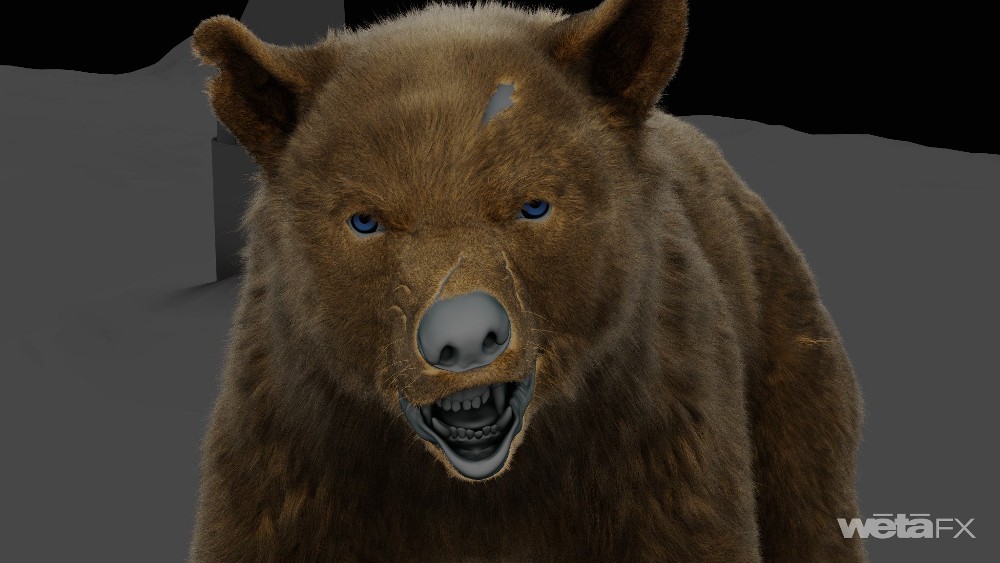
It was almost like this father-son hobby that we ended up having where we would spend evenings together and model stuff in a 3D package and figure out what it was, and it kind of snowballed from there. My parents were incredibly supportive all along. I think they realized that it wasn’t that I wasn’t good at school. I think I just had an issue with the teachers at the time and the level of authority that was presented to me. They were very supportive [of] my more creative endeavors, and we just figured out the path of, “how do I get there?”
In Switzerland, at the time, it was somewhat limited, so we figured multimedia was a really good avenue, because at least it incorporated, as the name implies, multiple mediums — moving media, After Effects, that kind of stuff. I slowly worked my way through that a little bit, and then I literally just went to London one weekend with a big box of show reels, hopped around a few different studios, dropped off my resume, and then got hired at MPC.
I ended up [as a runner] for about three months, and then I was basically a Junior Paint Artist, and then from there, just went [up] through the ranks. My background in visual effects is very much on the 2D side, so roto, paint, and compositing. That’s still the division that, to my heart, rings very true in my approach to things. I like to look at it through the lens of the compositor because I think it’s potentially a little bit more focused on the back end of the pipeline, rather than the intermediate steps. That’s just what I know. I guess that’s how my eye has been trained.
BTL: When you went to Wētā, were you following a similar trajectory, or did you become more of a generalist where you learned all different aspects of the work?
Hollander: I got hired as a Senior Compositor at the time at Wētā. The first show there was called The Water Horse, which was about this little Loch Ness monster that was splashing around in the little boy’s bathtub. And then when I came back for Avatar, I was basically employed as the Lead Compositor, and then from there, it was compositing all the way.
It was only later [that] my ambitions would grow a little bit, and I wanted to try something slightly bigger. I remember I approached Joe Letteri, our Senior Visual Effects Supervisor, and said, ‘I’d like to get into visual effects [supervising]. What do you think I need? Can I get your blessing for it, first and foremost?’ He said the two things that were important at the time for a Visual Effects Supervisor is, you need to know how to light a shot and understand the mechanics of the lighting, [and] he [also] said, ‘Most importantly, you need to know how to finish the shot. What does the shot need to get it through the door to match the client’s expectations [and] our internal expectations, and just use all the tools at your disposal as efficiently as he can?’
He said, ‘As a Compositing Supervisor (which was my role at the time), you’ve got that bit down because you’re in the trenches. “This is what we have, this is what you need, [and] this is the time we have [to get] what’s needed?”‘ That was a really great chat to have, and then, as things unfolded, I ended up having a kid, and it just didn’t feel like the right time to take on more work. When she was a little bit older, I approached the team again, and I did a little segue into a lighting role on Infinity War, the first of the last two Avengers movies. That was really cool, just seeing into the pipeline a little bit more. I had seen dailies, and I understood the notes that they would have to turn around, but I’d never actually sat on the tools and really figured out what it meant to do that. It was a nice throwback, in a way, to the days with my Dad when we would sit together and just play around with computers and lights and figure out how stuff worked. It gave me [some] really good insight into the 3D side of things.
With every new show, you learn something new. I think Cocaine Bear is very unique in that regard, where it feels very old school in a way — there is one CG asset that goes into a plate environment — but then it’s a fully photoreal, animated bear with layers of fat and fur. That presents a whole new challenge than if you make a movie in a desert, or a movie in outer space, or obviously, in the case of Avatar, a movie underwater. What’s always drawn me to this industry and this job is that [with] every new assignment, if you will, the learning curve changes, and there’s a whole new subject matter that you have to get your head [around], which is really great.
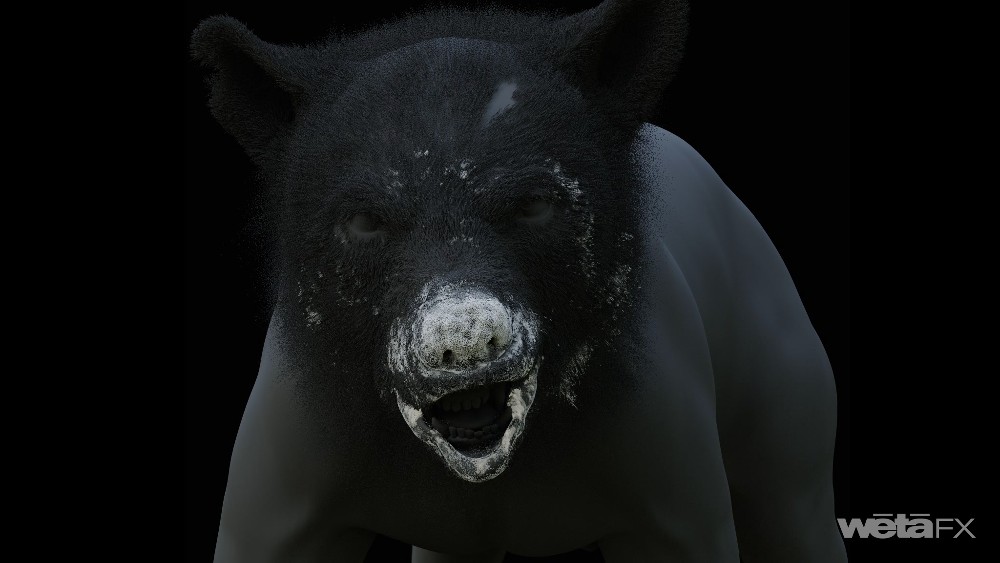
BTL: Surely, in the many decades Wētā has been around, they’ve created bears before, but never one with such personality. When Cokie isn’t on screen, you miss her greatly, and I’m glad the movie did well because hopefully, they’ll want to do more.
Hollander: You never know. It could be a family movie. Cokie and the cubs do a summer holiday camp or something. It’s interesting you mention that because [in] the very first meeting we had with Liz, the two briefs she had were that she wanted the audience to know that the bear isn’t inherently bad. She’s not vicious, she’s just after the drugs. She’s in the middle of all of this, and if you get in the way of either her cubs or her drugs, carnage will unfold. Unpacking that note really meant that she needed to be able to read the personality, she needed to swing on a dime like that. You need to be likable and terrifying in equal measure. There had to be a great level of subtlety in character exploration and character building in order to pull off that flip-flopping a little bit.
That was brief number one, and then the second one was that she needed the bear to be photoreal. If this thing doesn’t look 100 percent photoreal, it’s just gonna fall apart, especially with the level of personality and detail that we need from it. If it looks like Yogi Bear, people are gonna laugh at it and not emote with her or fear her. [Those were] two big tasks to be given at the beginning of the show. It was really great [though] because it gave us a real framework and a pyramid scheme, if you will. [Like], this is the tip. This is what we need to hit, and then everything else — any quirky behaviors, and blood and gore — that’s all stuff that can come secondary. But the base had to hold up to that kind of scrutiny. I’m really pleased that we hit that, and I know that Liz is incredibly pleased with the results as well.
BTL: What did you guys use for reference? Did you go to some zoos? The real bear still exists, stuffed, in a museum down in Kentucky, so did you go to see that?
Hollander: No, unfortunately, I didn’t. We went to Wellington Zoo here. They have a few sun bears, and that was the closest access that we had to real-life bears. We quickly realized that sun bears really fit the description of what a coked-out bear could be like. They look really cooked; their eyes are rolling around their head, their tongues flop out. They look a little bit dorky at the best of times, but they have an incredibly ferocious streak as well. We found some really great reference of a sun bear opening a coconut. The way that it clasped onto it with its hind legs and just ripped into it. Every now and then, it would casually look up and look around and just look so incredibly out of it. The eyes are just rolling around, but then it would go back into this ferocious killing mode.
We presented that to Liz and I think we were all a bit speechless because this is the bear. This is as close as we’ll get. Unfortunately, all the reference of black bears that we found [was] really great for things like, “how does the black bear climb? How does he walk? How does he run?” But most of them [are] pretty placid creatures. Fortunately, they’re not as we parsed [them] in the movie. They tend to just roam around, and they go into bins and get startled by small animals. There was good reference in there, but not quite for the coked-out behavior or the ferocious behavior. [But] sun bears were definitely the way to go.
We just amassed a huge collection. We did look at things like grizzly bear reference, which is really good for the fighting part of it, but we quickly realized that it didn’t quite work purely for the scale alone. Grizzlies are huge, and their physiology is quite different, [and] the way they interact and fight is very different as well. We tried to take cues from it, but we had to make a bit of a patchwork of how far into each bear behavior jar we reach before it breaks the character a little bit too much. It was something we had to season and taste throughout the movie. We’d show Liz something that looked cool, but then potentially, as the character built over the course of the movie, we’d go, “that’s not enough” or “that’s a bit too much.”
One of the nice things about it is we never fully put a pin in anything; we always kind of said, ‘Let’s keep this all at a level that’s incredibly close to being finished, but as the character changes, let’s make sure that we managed to keep those traits consistent across the whole movie, for the beats that we need to.’ It was a good workflow that we had, and I’m really glad that Liz was on board with that as well [and] didn’t demand, “No, this needs to be 100 percent done, and why haven’t you figured it out?” So it was a great collaboration in that regard.
BTL: Were you able to go to the set for this? I’m not sure where Liz shot the movie, but were you able to be there to make sure you had the plates and reference you needed?
Hollander: Yeah, absolutely. They shot the movie in Ireland. Due to COVID, there was quite a long run-up to having a firm plan in place. The shoot began in August, and Liz touched base with us in November, a year prior. I was definitely keen to go, I wanted to go up for pre-production as well, but because of the pandemic, I could have gone, but we had to weigh my safety as well because we didn’t have access to any vaccines at the time in New Zealand. The vaccines came in, but it was a tiered rollout. I was fairly young and fairly healthy, so I wasn’t at the top of their pyramid. We actually looked for an onset representation. We interviewed a few people to find someone suitable, and then, as luck would have it, two weeks before the shoot started, I actually managed to get a vaccination.
I think I missed the first week of shooting, but other than that, I was present for the whole thing, which was really great, because I was fully committed and prepared to basically check in with the team somewhat in real time from New Zealand, which I’d done a lot of in preproduction as well. It actually worked really well. We kind of make movies over the internet all the time now, but the time difference was definitely brutal because I would have meetings at 3 p.m. [in] Ireland, which was 2 a.m. [in] New Zealand, so I was up at all hours for a few weeks, just to liaise and touch base with the team. It was really great to be there. Obviously, being on set is always going to be helpful because you know exactly what you’re going to get [and] you can try and steer the process a little bit more.
I think most importantly, as with any shoot, you build a really good rapport with your filmmaker — with Liz, in this case — and with your producers, basically anyone who’s involved in the process thereafter. I think the level of trust that we ended up having throughout the whole shoot, and then the whole process, would have probably still happened, but I think it would have been harder to get there without actually having met in person. If you only ever talked to someone on screen, it’s a little bit hard to build that rapport. It was really fortunate that it all fell into place. I think the shoot was about seven weeks in the woods in Ireland. It was about as pleasant an experience as you could imagine.
BTL: Was Wētā the only VFX vendor on the movie or did you have other vendors doing other things, and if so, I imagine Wētā’s was focused on creating the bear, right?
Hollander: There were a few smaller companies involved with utility passes [and] cleanups. I think there were a few driving plates that had Irish signs in the background — markings on the road, that kind of stuff. I believe Rising Sun Pictures did the opening act with the plane. I wouldn’t know how many shots [there were], but I’d say a handful, maybe five to 10 shots. But yeah, that was it. In terms of anything related to the bear or environment building, other than the plane, that was Wētā exclusively. There was no other representation, if you will, on EST, so it [was] just us.
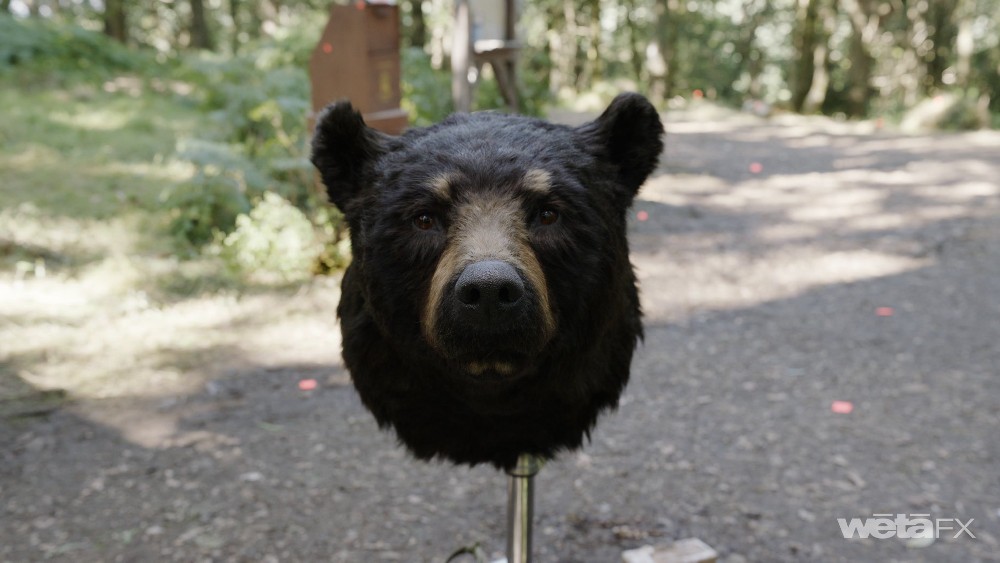
BTL: What did they have on set for Cokie? There are some scenes where you can just have a stuffed bear, but there were others where you need to have interaction. What did the actors have on set to interact with?
Hollander: Early on, there were really two crucial requirements we had. One was a basic stuffy — a bear head that was life-sized. We said, ‘Look, this is gonna be really important for you, because it gives us a lighting reference, and very importantly, it’s going to give your DP something to frame. This is going to be a head that gives your actors something to get acquainted to.’ That frequently happened in between takes [where] you’d see one of the actors up and close with the stuffy, figuring out what it was and who it was. I think psychologically, it helped them get into the character a little bit more, and imagine that this is the beast they’re staring down.
We definitely said, ‘Look, you need a performance actor, not so much for motion capture. It’s really hard to get mocap data of a human trying to be a quadruped. By design, you can walk with the same cadence and the same pacing, but the mechanics are vastly different. We’re not really going to gain anything from it, but it’s going to give you framing and cadence and give you something to direct and the actors something to interact back against.’
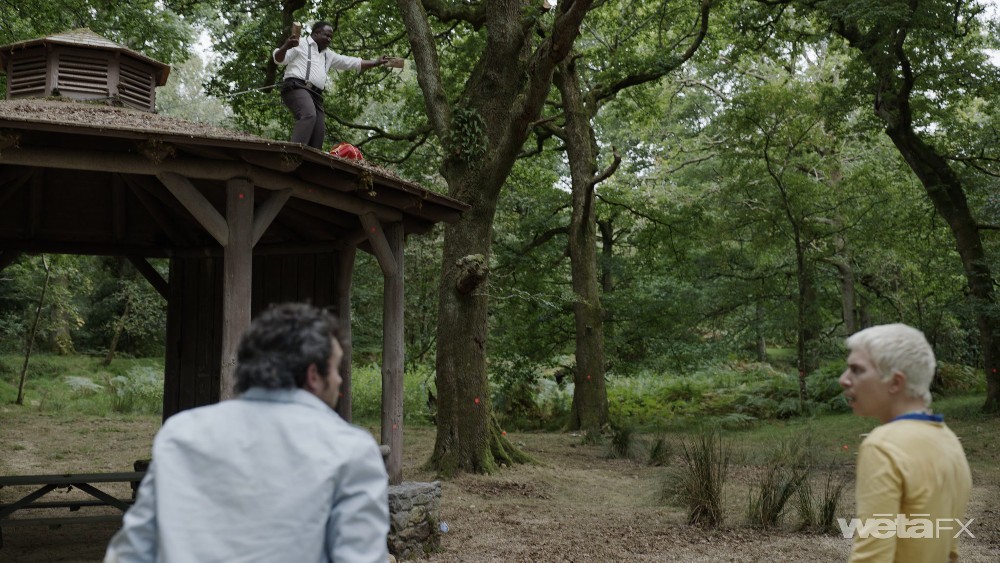
That was really just for shots where Cokie, or Allan Henry, the stunt performer who performed [as] Cokie, would just walk around and not directly interact. He had a helmet and [a] silicon prosthetic snout and some ping-pong balls for eyeline. The snout was interchangeable, so he had a few different harder snouts [and] he had a soft snout. With the soft snout, he could really get in there and nuzzle people around, because it was really nice and soft and squishy, so he wasn’t going to injure anyone. But then he had these prosthetic arm extenders, which we’ve used many times on multiple movies, but it just meant that he could actually walk as a quadruped, and at the same time, only had to be bipedal and stand up, [and] his snout would extend up and tilt down, so we had the heights pre-measured, and we knew if he’s on both legs, that is the [exact] height he has to be.
For scenes where he had to interact, we simplified it in some ways and took it further in another way. He dropped all of his equipment, and it was just him in a black spandex suit. For the scene where he’s wrestling Eddie (Alden Ehrenreich) at the gazebo, we figured out the difference in circumference between Allan and Cokie. We got the costume department involved, and we just wrapped a big piece of foam around Allan’s head. Cokie’s neck, we figured, would be right where Alan’s head ends and Cokie’s jawline would be just above Alan’s head. We padded him out so that [while] Alden Ehrenreich was interacting with him, he could actually hug something and have the correct circumference. In looking at that on set, [we thought], “Well, if he’s just going to hug Allan, there’s no way we can squeeze a big 500-pound bear in between, but if Allan is really big and girthy, then that’s actually going to work pretty well.”
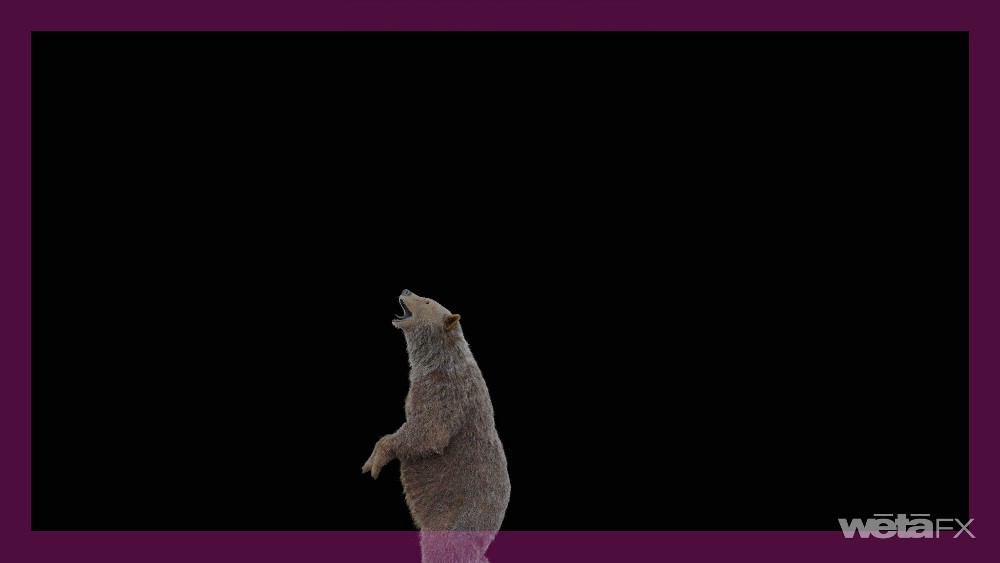
And it did work really well. Allan and Alden could really interact. It was nice and soft and squishy, so he could really bash him around a little bit. That is also a testament to Alden doing a lot of his stunt work himself, so I think the physicality between the two works so well because they did it for real. Really, the only caveat that we had to give Alan was, ‘Hey, pretend that your head is actually Cokie’s thorax, if you will. Pretend you have to angle away a little bit more, because we’ll have to stick a head on your head, which then has to rest on Eddie’s shoulder.’ That was really the only caveat that he had to take into account, but other than that, they could just go at it.
BTL: One thing that makes Cokie a little different from maybe any of the creatures Wētā has done is that it is a performance, so how did you work with Liz on Cokie once it went into the hands of the Wētā animators?
Hollander: What was really great [was], we managed to show her the process and explain [it] to her, so she knew that the first thing you’ll see is an animation representation, so it will look pretty good, but it’s not going to be lit. It’s not going to have any dynamics on it. That is not the final product. It’s only ever going to get better and better and better.
Along those same lines, we were able to flesh out an initial performance, show her, [and] she’d be like, ‘Yeah, that’s cool.’ And then once you basically added all the bells and whistles, the fur and tissue simulations, and the lighting, two things might happen — we either like it, or we might go, “Well, we like the performance, but the lighting and the quality of the fur make it really hard to see the performance.”
Do we tweak the lighting? We’re only going to do that so much because we have a plate we have to match to. Do we go back to animation and overplay the emotion that we want to purvey? It means that by the time it’s lit, it’s going to tone down a little bit again. There was a constant back and forth like that. Very quickly, she learned the mechanics of our animation puppet, if you will. She knew what we could do, and she also knew what would happen potentially, if you raised this more, this will fall apart, or this will distract a little bit. Where do we find the fine line between the two?
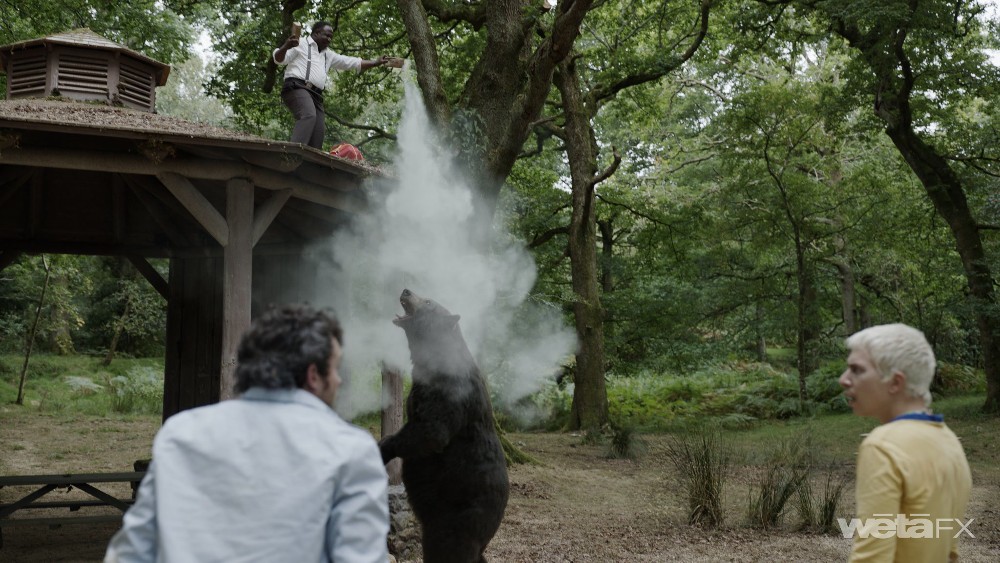
BTL: You mentioned lighting earlier. I know Wētā has a great lighting team, but there are certain scenes, like when the bear comes out of the back room at the ranger station, that just look amazing. How do you work with Liz’s DP to get that? Was that lighting done on set that you could actually use for reference, or do you still play around with it on your end?
Hollander: It’s a bit of both. The bear stuff that we had definitely helped the DP in lighting the scene because he had an understanding of where the bear would be and how the light [would] reveal it. He was incredibly gracious with his time and basically accommodated what we needed as much as he could. We would have a constant dialogue between the two of us and say, ‘Hey, look, in order to do this, I would love to do that. Does that work [for] you?’ Actually, that scene in the ranger station is a good example of that, because we all knew that Cokie has to emerge from the shadows. The space that she was occupying was actually tiny. That cupboard wasn’t very big. There’s definitely a little bit of cheating going on there in the shot to place her in there.
Rather than back ourselves into a corner by lighting the shots on set exactly how we needed to, we all agreed that it was a pretty nodal shot, so the camera was pretty locked-off. We said, ‘Let’s over-light it on set by a factor of about 1 1/2 stops, so we have all the range and all the blacks that we could ever want. We can go back in afterward and shape it as much as we need. We can take it down where we need it. We can add some atmospherics.’
That shot was definitely a little bit of an exception, where he was open to basically just writing us a blank check, making sure we had all the detail, but then we could shape it alongside him later on in post and say, ‘Hey, does this feel like you would have let it if this is what you wanted to do?’ He gave us his okay with that. A lot of it there was just about the timing, so when Cokie comes out, how much do we reveal at what time? We wanted to make it really spooky, so for instance, we had some little special eye lights in there. The first thing you see is just a little glint in the eyes, almost like a slight outline of the head, and you can see something moving, and then his snout comes into it. It was just easier to shape that digitally.
But for all other lighting setups, it was predominantly practical lights on set. The only exception being the waterfall environment, because obviously, we had to extend that top and bottom quite a bit, so anything that wasn’t on the physical platform they built, we had to just augment with digital lights. The general direction and tonality of the lights that we had practically [were] maintained throughout all of that.
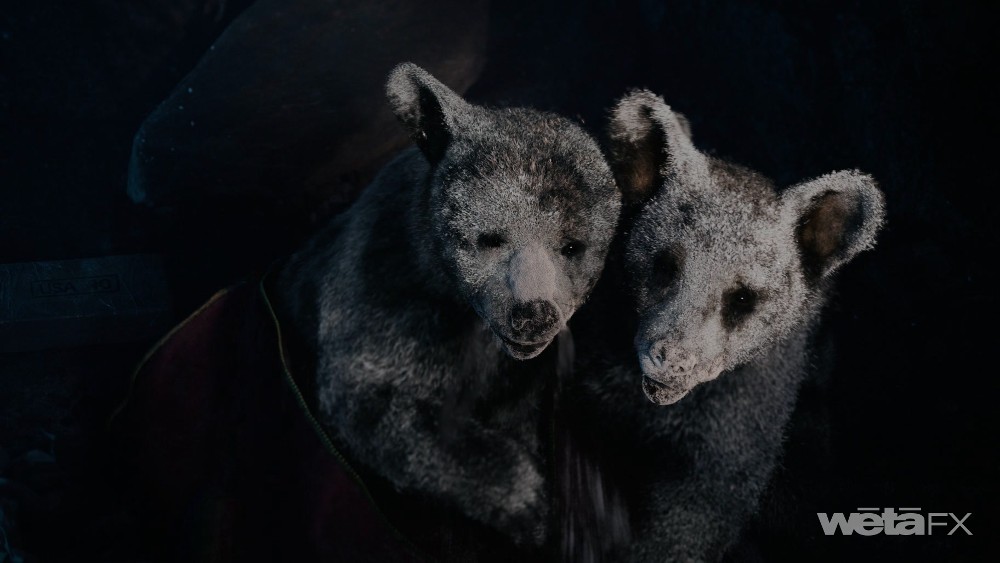
BTL: Before I let you go, I have to ask about the cubs. Was that just a matter of making a smaller version of Cokie and then working with Liz on their performances?
Hollander: Somewhat. I think the things we learned with Cokie, we could definitely transfer to the cubs. Under the skin, they’re the same deal, so you’ve got bones, you’ve got muscles, you’ve got fat, and then you got a layer of fur on top. There are definitely shared attributes. There’s nothing really that you can just transfer from Cokie directly on, so you couldn’t say, “Ah, take the look of the fur and apply it to the cubs,” because it’s a different model. But as a starting point, you can definitely look at the similar settings and go, like, “Well, what worked? What didn’t work? Let’s start with that.”
In terms of finding reference, the cubs are almost the easiest thing out of all the creatures that we did. If you look, there’s so much good reference of cubs just doing weird stuff. Like, we found a clip of cubs sneezing. [One] has a sneezing fit. So, “Hey, once it has done the coke, it has to sneeze,” and here’s the reference. The cubs being excited when Mama Bear climbs back up, jumping around like little puppies — there’s ample footage of that all around.
In terms of building the character of the cubs, I think that was actually quite easy. In terms of building the look, you’re right, it is, to an extent, copy-pasting what we had with Cokie, [it] just wasn’t as straightforward to do that in the pipeline. It was the last thing we did in terms of the creature work, and we had a really good-looking Mama Bear. I felt like it was quite a straightforward task to match them up.
Cocaine Bear is still playing in theaters nationwide, and it’s also available to buy or rent on all major digital/VOD platforms.





